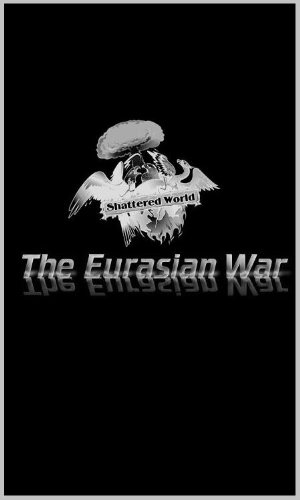Clash of Titans begins : Romania in Flames, Finland on thin ice
For several minutes night in the Ukrainian town of Chernovtsy seemed to become day as the thunderous crack of artillery fire cleaved the air and echoed off buildings. Townsfolk stood outside their doors,those in the streets stopped where they stood and looked in awe. All were glad they were not on the recieving end of such a hellish delivery of firepower. The impacts of ths shells were a distant constant rumbling and the freight train scream of their ballistic flight into Romania was worse than any ghost or evil creature out of stories. But niether could compare to the thunderous booms coming from the artillery battalion deployed near the village.
Almost lost in the deafening noise of the barrage, streams of aircraft droned overhead and Red Army trucks, tanks, and other strange motor vehicles clogged the town's narrow roads. War had come to the town of Chernovtsy, but it did not appear to the townsfolk that the Romanians would be coming to Chernovtsy. The Red Army, rather, would be coming to Romania.

The Soviet Union launches a largescale invasion of Romania. All of the Axis powers declare war on Russia within an hour of the invasion. Britain, France, and the U.S. condemn the invasion but urge both sides to avoid a greater war.
Along the three major fronts of the Soviet thrust over two thousand heavy artillery pieces open fire simaltaneously. Such a bombardment has not been seen since the height of the Great War. Soviet medium and heavy bombers range deep into Romania hitting vital transportation hubs, supply depots, as well as some industrial infrastructure. The Luftwaffe, not yet fully deployed inside Romania, can put up only a token defense in the air and the Romanian airforce is largely destroyed on the ground in the first hours of the invasion. The Red Airforce owns the skies over Romania.
Romanian border defenses are swept aside by the mammoth Soviet invasion. 700,000 soldiers and 3000 tanks have crossed the frontier. German Stukas and medium bombers are beginning to hit Soviet military units and supply lines but the tide of the Soviet advance can seemingly not be stemmed. German and Romanian forces are in a steady but organized withdrawal to the south and west. Britain,France and the US are franticly trying to confine the conflict to Romania with constant diplomatic efforts. Bucharest and other large Romanian cities burn after massed Soviet bomber attacks in the first few days of the war. Tens of thousands of civilians are feared dead.
The shattered remnants of the Romanian army,along with still arriving German units, begin to form a new line of defense in central Romania. Red Army units are within 10 km of the Romanian capital and within 35 km of the Romanian Polesti oilfields. The Soviets are hammering the Romanian capital with artillery and bombers. German fighters are taking a heavy toll on Russian bombers but by sheer numbers the Soviet bombers are wreacking havock and the Red Airforce still maintains air superiority despite increased Luftwaffe activity.
With Romanian and German resistance stiffening the Soviets require another month to grind 10 km into the outskirts of the Romanian capital. House to house fighting rages in the Romanian capital. German and Romanian snipers exact a heavy toll on Soviet infantry in the city and the Soviets begin to learn that rolling tanks into dense urban combat is not a good idea.
Northwest of Bucharest German forces launch sharp tactical counter attacks to slow down and confuse Soviet forces. But the Soviet axis of advance continues to grind westward. The Red Army is within 8 km of the Polesti oil fields.
German and Romanian forces destroy the Polesti oil fields just hours before Soviet soldiers occupy the facilities. Germany steps up it's bombing of Soviet supply lines and escalates the war by beginning to hit rail lines and supply depots in Odessa and other Soviet cities near the Romanian border in an effort to cut Soviet supply lines into Romania
The Red Airforce begins hitting transportation centers in Hungary and southeastern Germany. The Hungarian airforce and the Luftwaffe defend these attacks brilliantly downing dozens Soviet aircraft over a 24 hour period. From Liepzig to Odessa the air war now rages across eastern Europe.
A slow German buildup begins along the border with Soviet dominated Poland. Panzers, men, and supplies begin slowly flowing into Breslau and all along the Polish border. Germany is quietly massing over 2 million soldiers along the Polish frontier. The buildup is planned to be completed by late spring.
Along the borders between East Prussia, Germany, and Soviet Poland there are some artillery duels, small raids, and light bombing by both sides, but no actual active fronts. (rather like the "phony war" of OTL)
With the front largely stalled in southern Romania the Soviets open a new front, attacking northwest in order to cut off German supply routes through the northwestern part of Romania. The German General staff, under orders from Hitler, begins detailed planning for a massive total invasion of Soviet Poland to be launched sometime in 1939. Many in the German army oppose the idea, but not enough to change Hitler's mind.
Several hundred Soviet bombers hit central Berlin. Over a third of the Soviet bombers are downed but the attack is a propaganda coup for Stalin. Downtown Berlin suffers light damage and several thousand deaths. Hitler vows revenge for the "insult to the heart of our Reich"
With eastern Romania firmly in Soviet hands Stalin orders the southern advance to continue. The Red Army begins a renewed southern drive to push Romanian and German forces into Bulgaria. In northwestern Romania Soviet forces reach the city of Cluj but the advance is grinding to a halt as more and more german and Hungarian forces enter the area.
Soviet forces renew their war against Finland as 100,000 fresh Siberian soldiers pour west over the stalled lines. Finnish resistance remains fierce.
The Soviet advance in southern Romania reaches the Bulgarian border. Surviving German and Romanian forces flee into Bulgaria. The Soviets establish defensive lines and begin to consolidate their gains.
In the west Soviet forces are approaching the Hungarian border but are unaware of the German and Hungarian buildup occuring in southeastern Hungary.
With the outstanding performance of the few T-34's involved in the Romanian invasion just beginning to be appreciated the Soviet Union begins tooling up for largscale mass production of the deadly tank. Meanwhile German panzer commanders have become convinced that their panzers are in need of vast improvements. Mass production of an "upgunned" Panzer 3 model with a 50mm cannon begins. Development of the newer Panzer 4 model gains top priority.
Meanwhile, the resumed Soviet offensive in the arctic north is threatening to achieve a breakout as Finnish forces are being pressed to their absolute limits in the coastal stretches east of Helsinki. Luftwaffe and Red Airforce planes are clashing over southern Finland and the Baltic as German ships begin ferrying soldiers to aid in the defense of Helsinki. Soviet aircraft out of airfields along the Baltic coast are sinking some German shipping headed for Finland but not enough to cripple the effort. The Soviet fleet, what there is of it, remains bottled up in Murmansk and doesn't dare come out and face the German Navy. Finland has formally entered the Axis Powers and the war is spreading.
In the bowels of the Kremlin Stalin and his inner circle are pleased. The fascist lapdogs of Hitler in Finland and Romania are either on the run,defeated, or on the defensive. Soviet soldiers steadily near Helsinki and only a sliver of western Romania lays out of Soviet hands.
Feeling confident in himself and his country's position Stalin lights a new cigar and considers pressing his offensive further into Bulgaria, Hungary, or both. The Marshal of the Red Army favors Bulgaria, Beria favors waiting to consolidate their gains, Stalin hides his own thoughts. He has time to think, time to let the Fascist "Hitlerites" sweat in Berlin. First things first, he decides, and orders the rest of western Romania to be taken. The rest can wait for the moment.
In Berlin the scene is somewhat more somber. Hitler, the General Staff, and the Nazi party's elite inner circle all anxiously await the soon to be unleashed counter offensive to be launched out of Budapest. The fate of the attack could very well decide the outcome of the war. Should the counter attack fail Hitler is prepared to cut a deal with Stalin, giving the Soviets Romania in return for Soviet forces withdrawing from Finland. However, should the counter attack succeed Hitler is just as prepared to carry out his risky, and massive, invasion of Poland in the spring or summer.
The war can follow one of two paths, the fate of eastern Europe hangs in the balance.







